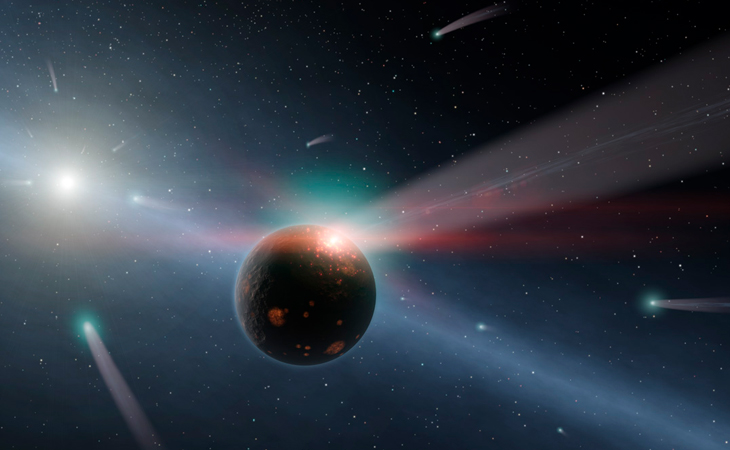Striking Evidence of Comet Delivering Water, Molecules to Earth-Like Planet

NASA/JPL-Caltech/Johns Hopkins University Applied Physics Laboratory
(ISNS) -- A dust cloud around a nearby star appears to be the debris from a collision between a giant comet and an Earth-like planet. The astronomers who made the observations claim that we may be witnessing a re-enactment of the comet barrage that struck Earth 4 billion years ago and presumably seeded our planet with water and other necessities for life as we know it.
Using NASA's Spitzer Space telescope, the astronomy team analyzed the warm dust surrounding Eta Corvi, a billion-year-old star 60 light years away from Earth in the constellation Corvus. Dust of this sort, which occurs in roughly 1 percent of stars, typically consists of the crushed-up rocks from a couple of asteroids smashing into each other.
However, Eta Corvi's dust proved to be extraordinary in that it contained signatures of water and carbon compounds, and researchers conclude that the dust is the remnants of a large comet in an upcoming paper in Astrophysical Journal.
"We observe what appears to be the result of a comet raining down on a terrestrial body in the habitable zone where life could potentially form," said lead author Carey Lisse of the John Hopkins University Applied Physics Laboratory in Laurel, Md.
Lisse and his colleagues have no direct proof of a planet on the receiving end of this cometary missile, but they concluded something rather big and rocky had to have shattered the comet into so many pieces. The best guess is a planet of roughly Earth size or smaller, orbiting Eta Corvi at a distance three times the Earth-sun distance. Because Eta Corvi is about 5 times brighter than the sun, this purported planet would be in the so-called habitable zone where water would remain in liquid form.
As for the comet, it most likely originated from the outskirts of the Eta Corvi system, similar to where our own solar system has its Kuiper belt, a large ring-shaped region that contains many small comet-like bodies, as well as big objects like Pluto. Evidence for a Kuiper belt-like region around Eta Corvi comes from 2005 observations of a large mass of cold debris circling the star at 150 times the Earth-sun separation.
Our Kuiper belt is fairly calm right now, but "Eta Corvi has a 'busy' Kuiper belt, like a swarm of bees, with comets flying out of the system and in towards the star," said Lisse. To explain what stirred up this "bees' nest," the authors propose a second planet of Jupiter's size or slightly smaller moving in the vicinity of Eta Corvi's Kuiper belt.
This whole story sounds like a Hollywood remake. Early in our own solar system's history, the giant planets -- Jupiter, Saturn, Uranus and Neptune -- appear to have shifted their orbital positions. This planetary shakeup disturbed our solar system's Kuiper belt, causing over 99 percent of the material to be ejected in random trajectories. Some of these comets may have contributed to the so-called late heavy bombardment, a dramatic uptick in the number of large impacts that occurred sometime around four billion years ago.
This comet onslaught may have delivered not only water to Earth, but also some of the organic building blocks of life. This possibility was recently highlighted by a meteorite, called Almahata Sitta, which landed in Sudan in 2008. Collected samples contain lots of organics, and surprisingly they have similar light-absorption signatures as the dust that Lisse and his colleagues have observed around Eta Corvi.
"We think this meteorite was a recent example of life's ingredients raining down," said Lisse.
Is it possible that Lisse's team has found a distant example of such a downpour?
That's a reasonable conclusion, according to Alessandro Morbidelli of the Observatory of Cote d'Azur in Nice, France.
"We have strong arguments for a late influx of comets from our outer solar system to the inner solar system," said Morbidelli.
Even if late heavy bombardments like this are rare, they are still bound to occur in other systems.
"Eta Corvi is probably one of those systems," said Morbidelli.
To obtain further verification, Lisse is suggesting that planet hunters train their eyes on Eta Corvi. He admits it won't be easy to detect the two planets that his group has proposed, since they are at relatively large distances from their host star. But planet detection is rapidly progressing.
"I'd bet a case of beer that in five years we'll have found planets around Eta Corvi," said Lisse.
Michael Schirber is a France-based science writer who has also written for Physical Review Focus, ScienceNOW, and Astrobiology Magazine.
